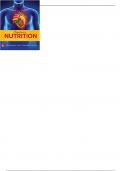,Perspectives in Nutrition, A Functional Approach, 2e (Byrd)
Chapter 1 The Science of Nutrition
1) The science of food; the nutrients and substances therein; and their action, interaction, and
balance in relation to health and disease is a definition of ________.
A) life
B) energy metabolism
C) nutrition
D) food science
Answer: C
Explanation: This is the definition of nutrition.
Difficulty: 1 Easy
Section: 01.01
Topic: Nutrition basics
Learning Objective: 01.01 Define the terms nutrition, carbohydrates, proteins, lipids (fats and
oils), vitamins, minerals, water, and calories.
Bloom's: Remember
Est Time: 0-1 minute
2) The leading cause of nutrition-related death in the United States is ________.
A) heart disease
B) homicide
C) suicide
D) diabetes
Answer: A
Explanation: Heart disease is the leading cause of death in US.
Difficulty: 1 Easy
Section: 01.01
Topic: Demographic trends and statistics; Cardiovascular disease
Learning Objective: 01.01 Define the terms nutrition, carbohydrates, proteins, lipids (fats and
oils), vitamins, minerals, water, and calories.
Bloom's: Remember
Est Time: 0-1 minute
1
Copyright © 2019 McGraw-Hill Education. All rights reserved.
No reproduction or distribution without the prior written consent of McGraw-Hill Education.
,3) Nutrients causing some signs of poor health when consumed in less than adequate amounts
are called ________.
A) essential nutrients
B) nonessential nutrients
C) nutritional supplements
D) trace nutrients
Answer: A
Explanation: Some signs of poor health will eventually occur less-than-adequate essential
nutrient consumption.
Difficulty: 1 Easy
Section: 01.01
Topic: Nutrition basics
Learning Objective: 01.01 Define the terms nutrition, carbohydrates, proteins, lipids (fats and
oils), vitamins, minerals, water, and calories.
Bloom's: Remember
Est Time: 0-1 minute
4) Energy-yielding nutrients include ________.
A) vitamins, minerals, and water
B) carbohydrates, proteins, and fats
C) trace minerals and fat-soluble vitamins
D) iron, vitamin C, and potassium
Answer: B
Explanation: Carbohydrates, proteins, and fats provide energy/calories.
Difficulty: 1 Easy
Section: 01.01
Topic: Nutrition basics
Learning Objective: 01.01 Define the terms nutrition, carbohydrates, proteins, lipids (fats and
oils), vitamins, minerals, water, and calories.
Bloom's: Remember
Est Time: 0-1 minute
2
Copyright © 2019 McGraw-Hill Education. All rights reserved.
No reproduction or distribution without the prior written consent of McGraw-Hill Education.
, 5) Sugars, starches, and dietary fibers are examples of ________.
A) proteins
B) vitamins
C) carbohydrates
D) minerals
Answer: C
Explanation: Sugars, starches, and dietary fibers are types of carbohydrates.
Difficulty: 1 Easy
Section: 01.01
Topic: Nutrition basics; Carbohydrates
Learning Objective: 01.01 Define the terms nutrition, carbohydrates, proteins, lipids (fats and
oils), vitamins, minerals, water, and calories.
Bloom's: Remember
Est Time: 0-1 minute
6) Which of the following are sources of carbohydrates?
A) grains
B) fruits
C) vegetables
D) All of these are sources of carbohydrates.
Answer: D
Explanation: Grains, fruits and vegetables all contain carbohydrates.
Difficulty: 1 Easy
Section: 01.01
Topic: Nutrition basics; Carbohydrates
Learning Objective: 01.01 Define the terms nutrition, carbohydrates, proteins, lipids (fats and
oils), vitamins, minerals, water, and calories.
Bloom's: Remember
Est Time: 0-1 minute
7) Which is NOT a complex carbohydrate?
A) glycogen
B) glucose
C) fiber
D) starch
Answer: B
Explanation: Glucose is a simple sugar
Difficulty: 1 Easy
Section: 01.01
Topic: Nutrition basics; Carbohydrates
Learning Objective: 01.01 Define the terms nutrition, carbohydrates, proteins, lipids (fats and
oils), vitamins, minerals, water, and calories.
Bloom's: Remember
Est Time: 0-1 minute
3
Copyright © 2019 McGraw-Hill Education. All rights reserved.
No reproduction or distribution without the prior written consent of McGraw-Hill Education.




